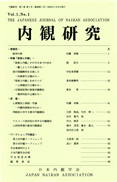Volume 16, Issue 1
Displaying 1-15 of 15 articles from this issue
- |<
- <
- 1
- >
- >|
OPENING REMARKS (EDITORIAL)
-
2010Volume 16Issue 1 Pages 1-2
Published: September 10, 2010
Released on J-STAGE: September 30, 2022
Download PDF (882K)
SPECIAL ARTICLES
-
2010Volume 16Issue 1 Pages 3-16
Published: September 10, 2010
Released on J-STAGE: September 30, 2022
Download PDF (1068K)
SPECIAL FOCUD 1
-
2010Volume 16Issue 1 Pages 17-18
Published: September 10, 2010
Released on J-STAGE: September 30, 2022
Download PDF (921K) -
2010Volume 16Issue 1 Pages 19-24
Published: September 10, 2010
Released on J-STAGE: September 30, 2022
Download PDF (992K) -
2010Volume 16Issue 1 Pages 25-27
Published: September 10, 2010
Released on J-STAGE: September 30, 2022
Download PDF (935K) -
2010Volume 16Issue 1 Pages 29-31
Published: September 10, 2010
Released on J-STAGE: September 30, 2022
Download PDF (935K)
SPECIAL FOCUD 2
-
2010Volume 16Issue 1 Pages 33-39
Published: September 10, 2010
Released on J-STAGE: September 30, 2022
Download PDF (954K) -
2010Volume 16Issue 1 Pages 41-44
Published: September 10, 2010
Released on J-STAGE: September 30, 2022
Download PDF (940K) -
2010Volume 16Issue 1 Pages 45-47
Published: September 10, 2010
Released on J-STAGE: September 30, 2022
Download PDF (937K)
ORIGINAL ARTICLES
-
2010Volume 16Issue 1 Pages 49-56
Published: September 10, 2010
Released on J-STAGE: September 30, 2022
Download PDF (1087K)
SHORT REPORT
-
2010Volume 16Issue 1 Pages 57-64
Published: September 10, 2010
Released on J-STAGE: September 30, 2022
Download PDF (1131K) -
2010Volume 16Issue 1 Pages 65-70
Published: September 10, 2010
Released on J-STAGE: September 30, 2022
Download PDF (989K)
REPORT
-
2010Volume 16Issue 1 Pages 71-87
Published: September 10, 2010
Released on J-STAGE: September 30, 2022
Download PDF (2947K) -
2010Volume 16Issue 1 Pages 89-99
Published: September 10, 2010
Released on J-STAGE: September 30, 2022
Download PDF (1296K) -
2010Volume 16Issue 1 Pages 101-108
Published: September 10, 2010
Released on J-STAGE: September 30, 2022
Download PDF (2242K)
- |<
- <
- 1
- >
- >|
